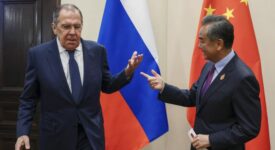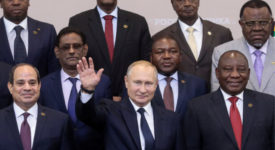NATO-Russia relations are “quickly rolling back” to that of the Cold War era and Moscow blames it on outdated NATO rhetoric, as Kremlin spokesman Dmitry Peskov commented back in May, and added that the Cold War rhetoric is embedded so deep within the alliance that “we were mistaken in thinking it was a thing of the past.” EUBulletin has recently interviewed a senior NATO official (whose name we can’t disclose for security and legal reasons) at NATO’s Brussels headquarters, who gives a deep insight into the background of the most serious crisis in the Alliance’s relations with Russia since the end of the Cold War.
The 2014 annexation of Crimea froze the mutual cooperation and, as a NATO official stressed, the NATO will never recognize its illegal annexation. At the same time, one can assume that Russia will not let Crimea go so easily either. Crimea was indeed a game changer for the NATO-Russia ties.
In 2011, Russia was still ‘labeled’, as the interviewed senior NATO official pointed out, as a strategic partner in the Alliance’s strategic document. Prior to Kremlin’s military adventure in the Donbas region, both sides had cooperated in a number of important areas – they had led operations against drug trafficking, jointly trained the Afghan military forces and cooperated in counter-terrorism efforts. However, in late 2014, both sides suspended both the joint operation against chemical weapons in Syria as well as the Russia-NATO Council, although the Alliance has sought to keep the channels of communication open.
NATO sees Russia as a revisionist power. Following the annexation, this view has been reinforced by the increasing activities of Russian armed forces, including unannounced and internationally unobserved military exercises, so-called snap exercises. A snap Russian exercise that took place between 16-21 March 2015 eventually involved 80,000 personnel, 12,000 pieces of heavy equipment, 65 warships, 15 submarines, and 220 aircraft – that is the scale that could mimic a war with the United States and/or the Alliance.
As snap exercises are often unannounced, the troops involved in them find out only last minute and thus there is no time to invite international observers, the NATO official explained These exercises are, however, not the only thing that makes the Baltic countries increasingly unnerved when it comes to safeguarding their security. Between January and October 2014, as many as 40 Russian military vessels had been seen near Latvian territorial waters, compared to only one in 2010.
The lack of perceived security triggered by Russia’s military activity too close to the borders with the EU and NATO countries has prompted a change in attitude towards the membership in the Alliance. For example, even non-member countries that traditionally kept distance from the Alliance, such as Finland and Sweden, have seen a rising public support for more ties with the NATO and eventually also membership. Both countries are actually planning on expanding their defense cooperation to counter the increasingly assertive Russian actions.
In 2010 Ukraine, the then President Yanukovych decided to take Ukraine’s NATO membership off the table, which was most likely also in line with the general public opinion. However, as the interviewed senior NATO official stressed, while in November 2013, only about 13-14 percent of Ukrainians were in favor of the membership, it was as many as 50 percent in the post-annexation period. The Alliance has responded to this “demand” and enhanced its military presence on the Eastern border, especially the troops in the three Baltic countries and Poland – more precisely, the Alliance currently has four international battalions stationed there.
On top of the frozen diplomatic ties and increasing number of Russia’s military drills, the Alliance is also concerned about the media in the country. The main purpose of the Russian media is to confuse and blur the line between facts and fabrication, though, according to the NATO official, the Alliance does not think that it would be wise to counter the propaganda using a tit-for-tat approach, which could become be a trap.
In a best-case scenario, the Russian military activity and the dissemination of government’s propaganda by its media are tools to distract the West from developments in Crimea and its own people to make them focus on the economic downturn that the country has been experiencing for a while. In a worst-case scenario, we might be witnessing a continuous strategy aiming to eventually invade the Baltics and lure both Europe and the Alliance into a hybrid conflict, which according to the senior NATO official, is the most likely type of an explosive conflict that could unfold.







